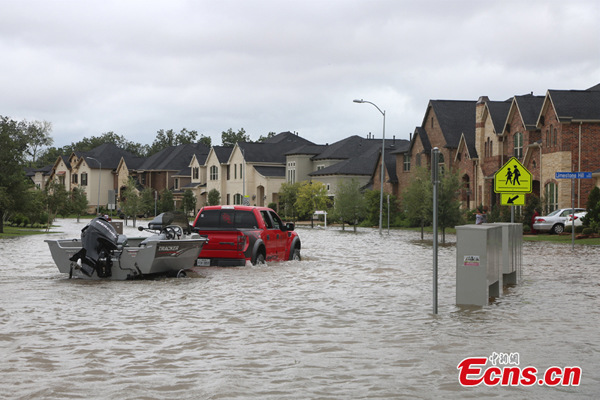
Hurricane Harvey causes mass flooding in Houston, Texas, Aug. 29, 2017. (Photo: China News Service/Zeng Jingning)
Hurricane Harvey, the biggest storm to hit Texas in 50 years, has not only caused damage on an unprecedented human scale, but is also set to be one of the most expensive natural disasters in U.S. history.
While most insurance analysts have given estimates of between 30 and 50 billion U.S. dollars, Imperial Capital, a leading New York-based insurer, told Bloomberg that the final cost could be as high as 100 billion U.S. dollars.
While still far behind the devastation of Hurricane Katrina in 2005 (159 billion U.S. dollars, according to JP Morgan), Harvey represents a growing trend of cities suffering unprecedented levels of economic harm, correlating with growing urbanization and a clustering of assets in areas vulnerable to disaster.
The economic risks facing an urbanized planet
In the 21st century, urbanization is set to grow rapidly, with 54 percent of the global population living in cities by 2014, according to the World Health Organization (WHO).
By 2060, the WHO believes that as many as one billion people could be living in low-lying coastal urban areas at risk of severe flooding. These urban areas will also pose a massive economic risk in terms of vulnerable assets.
Disasters over the last decade have shown the economic risks facing vulnerable urban areas – the 2011 earthquake and tsunami in Japan not only killed thousands of people, but it also cost an estimated 309 billion U.S. dollars, according to the Japanese government, making it by far the costliest natural disaster in history.
Dense urban areas require sufficient infrastructure to support their highly concentrated populations, but in the case of the Fukushima disaster, authorities underestimated the risks of establishing a nuclear power station in an earthquake and tsunami risk zone.
The resulting economic cost to Japan served as a wake-up call to other governments over their own infrastructure projects.
Sichuan quake's one trillion yuan repair bill
In 2008, China's National Development and Reform Commission responded to the Sichuan earthquake by investing one trillion yuan (150 billion U.S. dollars at the time) into better quality public buildings, infrastructure and housing.
The Sichuan earthquake struck on May 12, a date that now marks China's national day for disaster prevention and relief. While the UN Development Program estimates 80 percent of Chinese cities are at risk of natural disasters, the China National Commission for Disaster Reduction has looked to improve the country's capacity for coping with disaster.
In terms of economic damage from natural disasters, 2017 saw estimated losses nationwide of 1.87 billion yuan (271 million U.S. dollars) in the first quarter, a decrease compared to the eight previous years.
Trillions of dollars at risk
Hurricane Harvey again highlights the risks natural disasters pose to an increasingly urbanized world. The Texas Gulf Coast accounts for 600 billion U.S. dollars in economic activity each year, with the region acting as a key hub for the U.S. petroleum and chemicals industries, employing hundreds of thousands of people. More than 6.5 million people live in the Greater Houston area.
Before the storm, Texas was in the middle of a construction boom, with at least 50,000 homes being built in Houston alone. According to local media, insurers estimate that two billion U.S. dollars' worth of property has been damaged, with the real cost due to be counted in the wake of the disaster.
According to a Christian Aid report released last year, natural disasters could put 3.5 trillion U.S. dollars' worth of assets at risk in Miami alone by 2070.
Guangzhou in south China's Guangdong Province could suffer property, infrastructure and business losses of 3.4 trillion U.S. dollars in the event of a natural disaster just over 50 years from now. Six of the top 20 most at risk cities in 2070 are in China, according to Christian Aid's report.
The United Nations in recent years has called for greater investment in disaster prevention, with Robert Glasser, the UN Secretary-General's Special Representative for Disaster Risk Reduction, saying in a press release on Monday that "events in Texas…[underline] the importance of having in place common-sense restrictions to ensure that critical infrastructure is located outside flood plains or at sufficient elevations."
Glasser went on to say that "strong risk governance needs to be part and parcel" of the growing urban infrastructure needs of an increasing world population.


















































